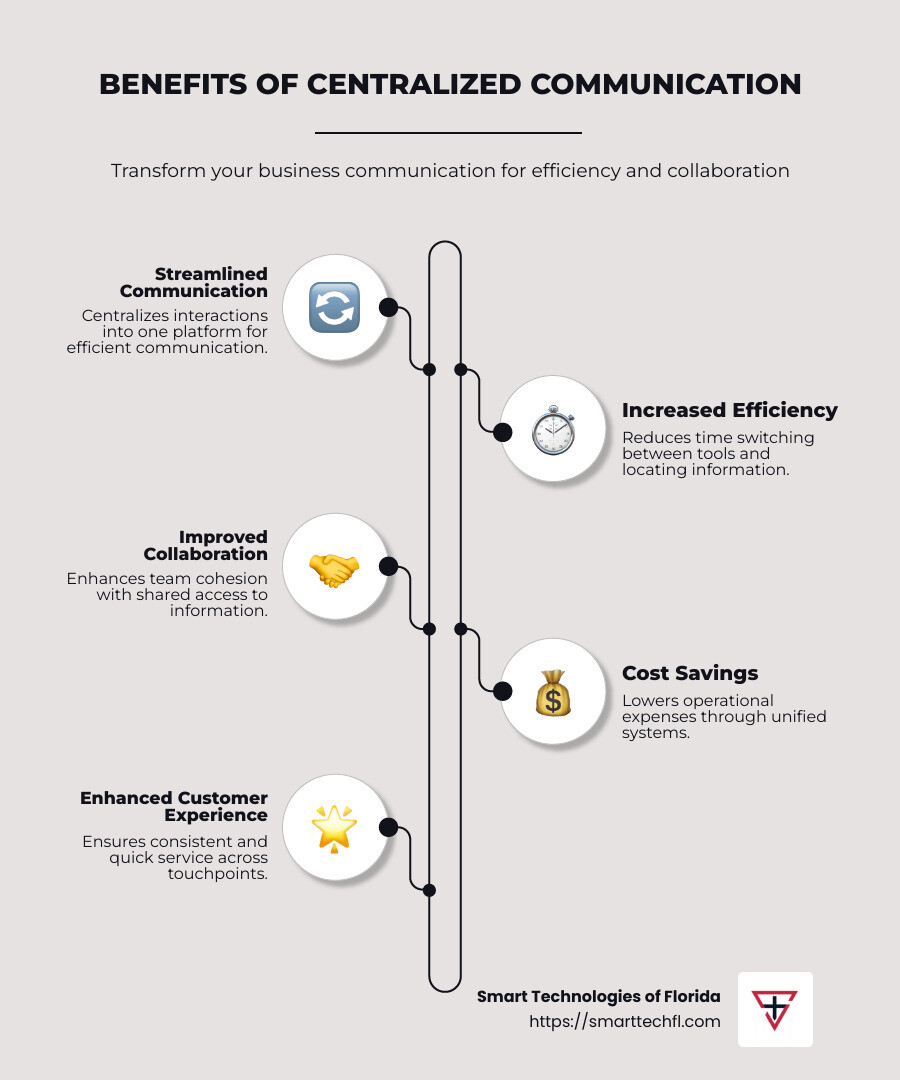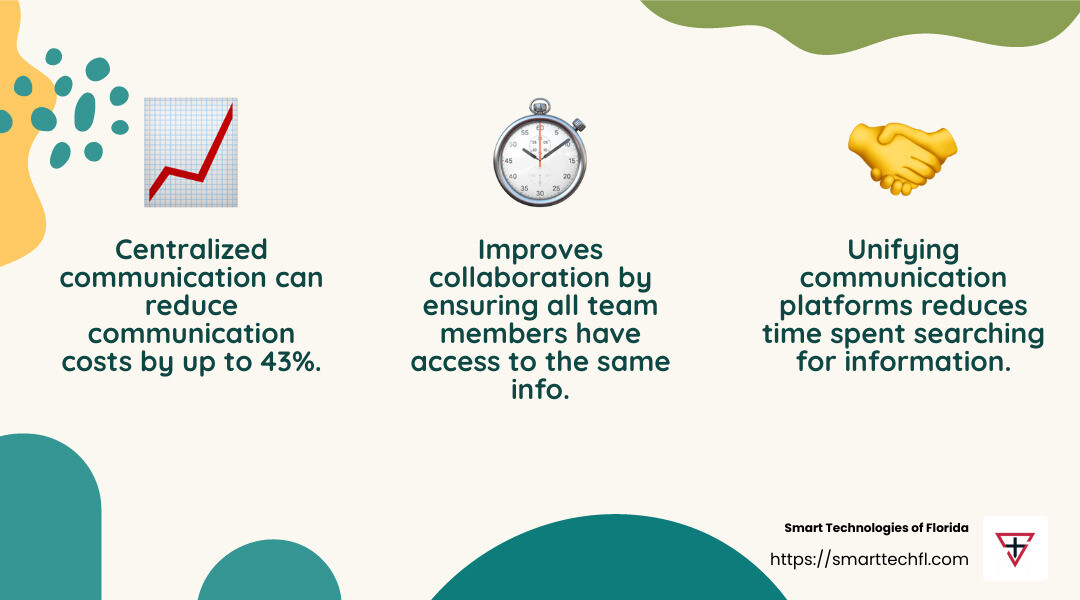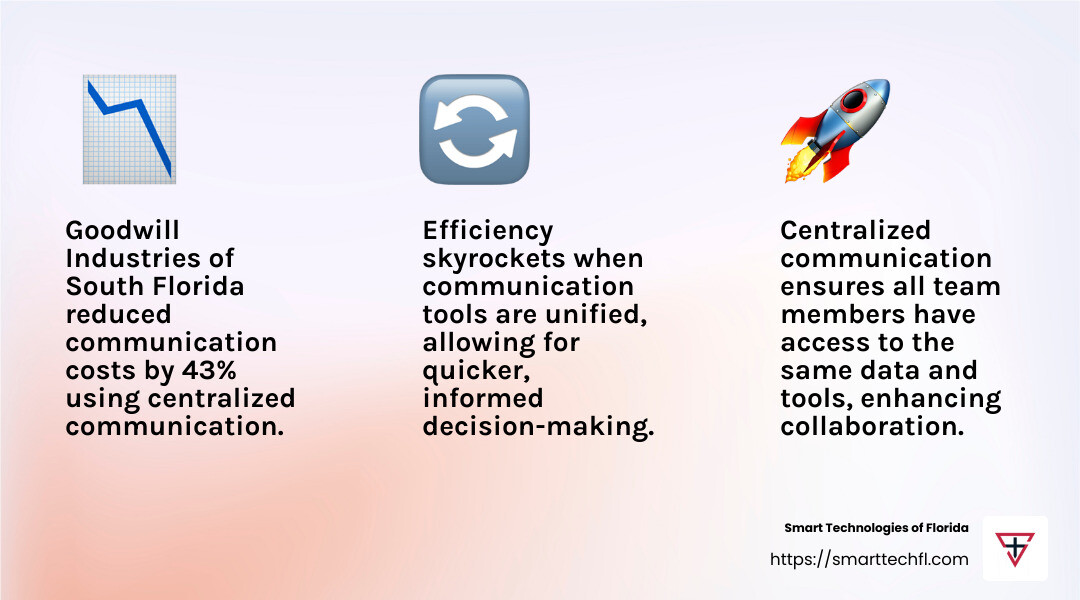Why Centralized Communication is Essential for Modern Enterprises
Centralized communication is changing how modern enterprises operate and thrive in today’s digital landscape. This approach consolidates all your business communication into a single, easy-to-manage system. For those seeking a quick understanding, here are the essentials:
- Streamlined Communication: Centralizes interactions across various channels into one platform.
- Increased Efficiency: Reduces time spent switching between tools and chasing information.
- Improved Collaboration: Improves team cohesion by ensuring everyone has access to the same information.
- Cost Savings: Lowers operational expenses through unified systems and reduced maintenance.
- Improved Customer Experience: Provides consistent and quick service across all customer touchpoints.
In an era where digital solutions are essential, centralized communication is becoming a critical component for businesses. It offers an opportunity for change, leading to greater operational efficiency and improved customer engagement. By adopting this approach, companies can streamline operations, cut costs, and foster an environment where both employees and customers are empowered.

The Importance of Centralized Communication
In today’s business world, centralized communication is no longer just an option—it’s essential. By bringing all communication into one hub, businesses can achieve remarkable improvements in how they operate and collaborate.
Operational Efficiency
Centralized communication boosts operational efficiency by reducing the chaos of scattered messages and tools. Imagine trying to juggle emails, chats, and project updates from different platforms. It’s a recipe for confusion and wasted time. By consolidating everything into one place, employees spend less time searching for information and more time on productive work.
For example, Goodwill Industries of South Florida saw a 43% reduction in communication costs by switching to a unified system. This isn’t just about saving money—it’s about making sure every minute counts.
Streamlined Processes
With all communications centralized, processes become streamlined. Instead of hopping between different apps and channels, teams have everything they need at their fingertips. This means fewer bottlenecks and faster decision-making.
Consider the case of using ClickUp as a centralized hub. Features like real-time chat and collaboration tools mean that team members can resolve issues and make decisions without leaving the platform. This kind of integration is key to keeping workflows smooth and efficient.
Improved Collaboration
Collaboration thrives when everyone is on the same page. Centralized communication ensures that all team members have access to the same information and tools, breaking down silos and fostering a more united work environment.

By using a centralized platform, teams can share documents, plan projects, and communicate seamlessly. This not only improves teamwork but also encourages innovation by allowing ideas to flow freely across the organization.
In summary, centralized communication is crucial for modern enterprises aiming for success. It improves operational efficiency, streamlines processes, and significantly improves collaboration. As businesses continue to evolve, adopting a centralized approach will be key to staying competitive and thriving in the digital age.
Key Benefits of Centralized Communication
Centralized communication offers a range of benefits that transform how businesses operate. Let’s explore some of the key advantages:
Streamlined Communication
When communication is centralized, it becomes streamlined and efficient. Imagine having all your emails, chats, and project updates in one place. No more jumping between apps or missing important messages.
This setup reduces the time spent searching for information and ensures that everyone is in the loop. For instance, organizations using platforms like ClickUp find that team members can directly reach out and collaborate without the hassle of switching tools. This kind of streamlined communication makes it easier to focus on tasks that matter.
Broadened Scope
Centralized communication broadens the scope of how teams interact. By breaking down barriers between departments, it fosters a more inclusive and collaborative environment. This is crucial for innovation and problem-solving.
Consider a scenario where customer feedback, product updates, and marketing strategies are all accessible through a single platform. This not only improves understanding across teams but also ensures that everyone has a voice in the decision-making process.
Increased Efficiency
Efficiency skyrockets when communication is centralized. With all necessary information at their fingertips, employees can make informed decisions quickly.
A great example is Goodwill Industries of South Florida, which achieved a 43% reduction in monthly communication costs thanks to a unified system. This isn’t just about cutting costs; it’s about making sure every second is used productively.
Improved Collaboration
Collaboration improves when everyone is on the same page. Centralized communication ensures that team members have access to the same data and tools, fostering a culture of collaboration.
Using features like real-time chat and document sharing, teams can work together seamlessly. This not only boosts teamwork but also encourages creativity and innovation. By having a shared space for ideas, organizations can harness the collective brainpower of their entire workforce.
Centralized communication is a game-changer for modern enterprises. It streamlines communication, broadens the scope of collaboration, increases efficiency, and significantly improves teamwork. Adopting a centralized approach is not just beneficial; it’s essential for staying competitive in today’s business world.

Next, we will explore the top features of centralized communication platforms that make these benefits possible.
Top Features of Centralized Communication Platforms
Centralized communication platforms come equipped with features that make them indispensable for modern enterprises. Let’s explore some of the most crucial ones:
Unified Platform
A unified platform is the backbone of centralized communication. It brings together all communication channels—emails, chats, video calls, and more—into one cohesive system. This eliminates the need to switch between multiple apps, saving time and reducing confusion.
Imagine having a single dashboard where you can manage everything from team discussions to customer inquiries. This integration not only streamlines communication but also ensures that all interactions are easily accessible and organized.
Real-Time Chat
Real-time chat is a game-changer for team collaboration. It allows employees to communicate instantly, share updates, and solve problems on the spot. This feature is essential for maintaining momentum in environments.
Platforms that offer real-time chat enable teams to connect seamlessly, whether they are in the same office or spread across the globe. This immediacy fosters a sense of camaraderie and ensures that everyone stays in the loop.
Integrations with CRMs
Integrating with Customer Relationship Management (CRM) systems is another vital feature of centralized communication platforms. These integrations with CRMs allow for a deeper understanding of customer interactions and streamline the sales process.
By connecting communication tools with CRM data, businesses can provide personalized customer experiences and improve service delivery. This integration ensures that every customer touchpoint is informed by the latest data, enhancing both efficiency and satisfaction.
These features—unified platforms, real-time chat, and CRM integrations—are what make centralized communication platforms so powerful. They bring together disparate tools into a single, efficient system, changing how businesses communicate and collaborate.
Next, we will discuss how to implement centralized communication in your organization effectively.
Implementing Centralized Communication in Your Organization
Transitioning to a centralized communication system can seem daunting, but with the right approach, it becomes a smooth process. Here’s how to get started:
Evaluate Communication Needs
Before diving into centralized communication, take a step back and evaluate your organization’s current communication landscape. Ask yourself:
- What are the current communication tools in use?
- Where do bottlenecks occur?
- How do different departments interact?
Understanding these aspects helps identify gaps and areas that need improvement. This evaluation is crucial for tailoring a centralized system that meets your specific needs.
Choose the Right Tools
Once you’ve mapped out your needs, the next step is selecting the right tools. Look for platforms that offer:
- Unified communication: Ensure the platform can integrate emails, chats, video calls, and more into one system.
- Real-time chat: This feature is essential for quick problem-solving and maintaining team momentum.
- CRM integrations: Connecting with CRM systems can improve customer interactions and streamline workflows.
Consider tools that are user-friendly and scalable to accommodate growth. The goal is to simplify communication, not complicate it.
Train Your Team
Implementing new technology is only successful if your team knows how to use it. Invest time in training sessions to ensure everyone is comfortable with the new system. Focus on:
- Demonstrating the benefits of centralized communication.
- Providing hands-on training sessions.
- Offering ongoing support and resources.
Training not only helps employees adapt but also fosters enthusiasm for the new system. When everyone understands the advantages, they are more likely to accept the change.
By evaluating your needs, choosing the right tools, and training your team, you set the stage for a successful transition to centralized communication. This approach not only improves efficiency but also improves collaboration across your organization.
Next, we’ll dive into some frequently asked questions about centralized communication to address common concerns and misconceptions.
Frequently Asked Questions about Centralized Communication
What is centralized communication?
Centralized communication is the practice of funneling all business conversations into one place. Instead of juggling emails, chats, and calls across multiple platforms, everything is brought together in a single, unified system. This approach makes it easier for teams to share information and ensures nothing slips through the cracks.
Think of it as a one-stop shop for all your communication needs. Whether it’s a chat with a colleague or a customer inquiry, having everything centralized helps keep everyone on the same page.
How does centralized communication improve efficiency?
Centralized communication boosts efficiency by streamlining how information flows through an organization. Here’s how:
- Reduced Redundancy: With all communication tools integrated, there’s no need to switch between apps, saving time and reducing the chance of losing important messages.
- Faster Decision-Making: Real-time updates and alerts ensure that teams can make informed decisions quickly without waiting for emails or meetings.
- Improved Collaboration: Features like document sharing and collaborative spaces mean team members can work together seamlessly, regardless of location.
A case study from Goodwill Industries of South Florida highlights these benefits. They saw a 43% reduction in phone bills and improved customer service metrics after adopting a unified communication system.
What tools are essential for centralized communication?
To achieve effective centralized communication, certain tools and features are crucial:
- Unified Platforms: These bring together email, chat, video conferencing, and more into one interface. No more jumping between apps.
- Real-Time Chat: Allows for quick and easy communication, helping teams to resolve issues on the fly.
- CRM Integrations: Connecting communication platforms with CRM systems improves customer interactions by keeping all client information accessible and up-to-date.
- Collaboration Tools: Features like shared documents and whiteboards encourage teamwork and idea-sharing.
Platforms like ClickUp offer many of these features, such as real-time chat, collaboration on documents, and even integration with CRM tools for a holistic approach to communication.
By focusing on these tools, organizations can ensure they are well-equipped to handle the demands of modern communication, leading to better outcomes and improved efficiency.
Conclusion
At Smart Technologies of Florida, we believe that centralized communication is not just a tool but a strategic change agent for modern enterprises. Our people-centric approach ensures that every solution we offer is custom to align with your unique business goals.
Strategic Change with Centralized Communication
Centralized communication transforms how businesses operate. It breaks down silos and fosters a culture of transparency and collaboration. By integrating all communication channels into a single platform, we help you streamline processes, improve decision-making, and boost efficiency. This strategic change is crucial for staying competitive in today’s business environment.
Our People-Centric Approach
With over 23 years of experience, we understand that technology alone doesn’t drive success—people do. That’s why we focus on empowering your team with the right tools and training. Our solutions are designed to improve your team’s ability to communicate effectively, whether they’re in the office in Daytona Beach, FL, or working remotely.
By choosing Smart Technologies of Florida, you’re not just investing in technology; you’re investing in a partner committed to your success. Our solutions are built to adapt and grow with you, ensuring that your communication strategies remain effective and aligned with your business objectives.
Ready to transform your business communication? Visit our Business Communication Solutions page to learn more about how we can help you achieve seamless and efficient communication.












